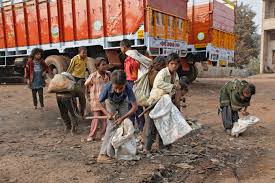Efforts to co-ordinate international labour standards have become more prominent with increasing globalization.The supporters of these standards argue that a set of minimal labour standards is necessary to promote fair competition and to facilitate efficient operations of the labour market. The opponents argue that it is counterproductive interference in the working of the free market.Prohibition of forced labour and elimination of exploitative child labour are part of core areas of labour standards. The liberalization can also lead to multiple equilibrium in case of child labour. Another issue that came up in case of child labour is the issue of imperfections in credit markets.
Child labour can be Pareto inefficient even in model where parents are fully altruistic towards their children because there can be a commitment problem between parents and children. If parents ran out of resources to educate the child , they have to borrow against child’s future income but a commitment problem arises because when children are adult , their parents cannot control them and children cannot credibly commit to transfer part of their income to the parents to compensate them.
The effect of liberalization is that wages of skilled workers would increase and therefore increase in wages will bring down the amount of child labour because the education level will increase.On the other hand demand of education will decline if unemployment increases for educated due to liberalization.
Returning to labour standards and child labour,tilts towards directs measures like school improvements,credits and and increase in adult wages instead of partial ban on child labour produced goods.
The impact of liberalization on child labour could be similar to those for women for example ‘the added work effect ‘ due to macro shocks can increase child labour . The stabilization policies reduce the aggregate demand for goods and services and reduced demand for labour .Labour supply can veer from formal to informal sector and the wage rate for the adults is likely to fall.There may be a substitution effect of adults replacing child labour. Also the shadow price of education may decline with decline in the wage rate for children and demand for education may increase so,due to these effect child labour can decline.
On the other hand due to income effect child labour may increase. In this trade reform, the intensification of international trade is likely to increase the demand for labour particularly for in the formal sector. The wage rate of both adults and children may increase and because of global competition prices ,employers reap benefits of children because they are paid less. As a consequence of expansion of trade ,child labour may increase in short run but in long run due to faster economic growth child labour may decline.
Click here for government certifications





6 Comments. Leave new
Nicely written. It is indeed the first article i’ve read that relates a social issue, child labour and economics. It was great going through the article. Keep up the good work.
Child labour is a crime not only to that child but also to the nation.
well researched
good one 🙂
Child labout is a menace to the country 😀
They one who needs to have Books and pens/pencil in their hands :/ they carry and work for their daily food 😀
This should be stoped 😀
Governement should introduce may new policies 🙁 that contains strict rules against the people who still want small children on their shops 😛 🙁
Very well written 😀 and good work by puting light on this social issue 😀 😀
india has always been trying to stop it. But until poverty persists, child labour wont stop.